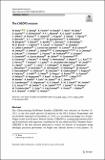The CHEOPS mission
Abstract
The CHaracterising ExOPlanet Satellite (CHEOPS) was selected on October 19, 2012, as the first small mission (S-mission) in the ESA Science Programme and successfully launched on December 18, 2019, as a secondary passenger on a Soyuz-Fregat rocket from Kourou, French Guiana. CHEOPS is a partnership between ESA and Switzerland with important contributions by ten additional ESA Member States. CHEOPS is the first mission dedicated to search for transits of exoplanets using ultrahigh precision photometry on bright stars already known to host planets. As a follow-up mission, CHEOPS is mainly dedicated to improving, whenever possible, existing radii measurements or provide first accurate measurements for a subset of those planets for which the mass has already been estimated from ground-based spectroscopic surveys. The expected photometric precision will also allow CHEOPS to go beyond measuring only transits and to follow phase curves or to search for exo-moons, for example. Finally, by unveiling transiting exoplanets with high potential for in-depth characterisation, CHEOPS will also provide prime targets for future instruments suited to the spectroscopic characterisation of exoplanetary atmospheres. To reach its science objectives, requirements on the photometric precision and stability have been derived for stars with magnitudes ranging from 6 to 12 in the V band. In particular, CHEOPS shall be able to detect Earth-size planets transiting G5 dwarf stars (stellar radius of 0.9R⊙) in the magnitude range 6 ≤ V ≤ 9 by achieving a photometric precision of 20 ppm in 6 hours of integration time. In the case of K-type stars (stellar radius of 0.7R⊙) of magnitude in the range 9 ≤ V ≤ 12, CHEOPS shall be able to detect transiting Neptune-size planets achieving a photometric precision of 85 ppm in 3 hours of integration time. This precision has to be maintained over continuous periods of observation for up to 48 hours. This precision and stability will be achieved by using a single, frame-transfer, back-illuminated CCD detector at the focal plane assembly of a 33.5 cm diameter, on-axis Ritchey-Chrétien telescope. The nearly 275 kg spacecraft is nadir-locked, with a pointing accuracy of about 1 arcsec rms, and will allow for at least 1 Gbit/day downlink. The sun-synchronous dusk-dawn orbit at 700 km altitude enables having the Sun permanently on the backside of the spacecraft thus minimising Earth stray light. A mission duration of 3.5 years in orbit is foreseen to enable the execution of the science programme. During this period, 20% of the observing time is available to the wider community through yearly ESA call for proposals, as well as through discretionary time approved by ESA’s Director of Science. At the time of this writing, CHEOPS commissioning has been completed and CHEOPS has been shown to fulfill all its requirements. The mission has now started the execution of its science programme.
Citation
Benz , W , Broeg , C , Fortier , A , Rando , N , Beck , T , Beck , M , Queloz , D , Ehrenreich , D , Maxted , P F L , Isaak , K G , Billot , N , Alibert , Y , Alonso , R , António , C , Asquier , J , Bandy , T , Bárczy , T , Barrado , D , Barros , S C C , Baumjohann , W , Bekkelien , A , Bergomi , M , Biondi , F , Bonfils , X , Borsato , L , Brandeker , A , Busch , M-D , Cabrera , J , Cessa , V , Charnoz , S , Chazelas , B , Collier Cameron , A , Corral Van Damme , C , Cortes , D , Davies , M B , Deleuil , M , Deline , A , Delrez , L , Demangeon , O , Demory , B O , Erikson , A , Farinato , J , Fossati , L , Fridlund , M , Futyan , D , Gandolfi , D , Garcia Munoz , A , Gillon , M , Guterman , P , Gutierrez , A , Hasiba , J , Heng , K , Hernandez , E , Hoyer , S , Kiss , L L , Kovacs , Z , Kuntzer , T , Laskar , J , Lecavelier des Etangs , A , Lendl , M , López , A , Lora , I , Lovis , C , Lüftinger , T , Magrin , D , Malvasio , L , Marafatto , L , Michaelis , H , de Miguel , D , Modrego , D , Munari , M , Nascimbeni , V , Olofsson , G , Ottacher , H , Ottensamer , R , Pagano , I , Palacios , R , Pallé , E , Peter , G , Piazza , D , Piotto , G , Pizarro , A , Pollaco , D , Ragazzoni , R , Ratti , F , Rauer , H , Ribas , I , Rieder , M , Rohlfs , R , Safa , F , Salatti , M , Santos , N C , Scandariato , G , Ségransan , D , Simon , A E , Smith , A M S , Sordet , M , Sousa , S G , Steller , M , Szabó , G M , Szoke , J , Thomas , N , Tschentscher , M , Udry , S , Van Grootel , V , Viotto , V , Walter , I , Walton , N A , Wildi , F & Wolter , D 2020 , ' The CHEOPS mission ' , Experimental Astronomy , vol. 899 , no. 1 , 73 . https://doi.org/10.1007/s10686-020-09679-4
Publication
Experimental Astronomy
Status
Peer reviewed
ISSN
1572-9508Type
Journal article
Collections
Items in the St Andrews Research Repository are protected by copyright, with all rights reserved, unless otherwise indicated.

